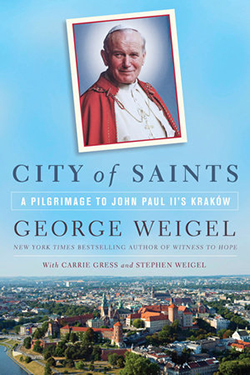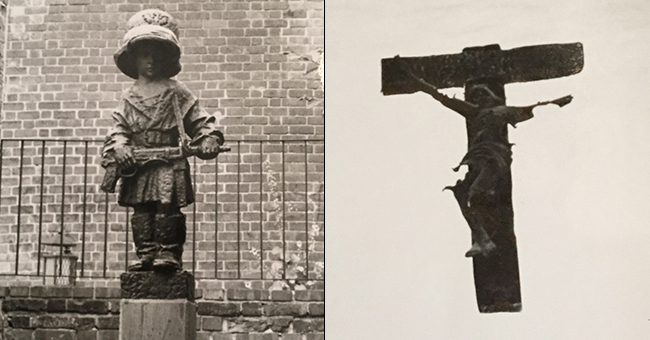Countdown to World Youth Day: Marking the Holocaust and Warsaw’s Uprisings

Different countries have chosen various days of the calendar to recognize the Holocaust. Poland marks the solemn occasion on April 19, the anniversary of the start of the Warsaw Ghetto Uprising.
World War II was perhaps the darkest period of Poland’s history. It is difficult to wrap one’s mind around just how awful it was. Certainly it was beyond horrific for the Jews that made up 10 percent of Poland’s population, but it was also a nightmare for non-Jewish Poles. The Nazis, in their maniacal drive to create the “master race,” killed six million Jews from all over Europe, while nearly two million non-Jewish Poles were killed for their “inferior race.” Twenty percent of the Polish population died in World War II.
While much attention is given to the death camps, such as Auschwitz and Treblinka, stories of Jews and Poles fighting back against their Nazi oppressors are not well known.
The Warsaw Ghetto Uprising 1943

The Warsaw Ghetto Uprising was the largest revolt by the Jews during World War II. Spurred on by a small revolt in the Warsaw ghetto on January 18, 1943, the April uprising in Poland’s capital was a desperate effort by the remaining Jews to avoid deportation to the Treblinka extermination camp.
On the eve of Passover, April 19, 1943, seven hundred and fifty scarcely armed fighters launched their ragtag offensive against well-trained and armed Germans. Their revolvers, hand grenades, and Molotov cocktails were eventually overcome on May 16, 1943, when the Nazis set fire to the ghetto, section by section, leading to the death of 13,000 Jews through direct contact with flames or smoke inhalation. The ghetto was liquidated; the remaining Jews (somewhere between thirty seven and fifty seven – the numbers vary) were sent to Treblinka and other death camps shortly thereafter. Few survived the war.
After the ghetto was liquidated, the Great Synagogue of Warsaw, built in 1877, was blown up. General Jürgen Stroop, who put together a photo album documenting the German suppression of the Warsaw Ghetto Uprising, wrote a caption: "There is no longer a Jewish quarter in Warsaw."
On the 50th anniversary of the Warsaw Ghetto Uprising, Pope John Paul II wrote, “As Christians and Jews, following the example of the faith of Abraham, we are called to be a blessing to the world (cf. Gen. 12:2ss). This is the common task awaiting us. It is therefore necessary for us, Christians and Jews, to be first a blessing to one another.”
The Warsaw Uprising 1944
After nearly five years of Nazi occupation, the Polish Resistance Home Army launched an offensive to free Warsaw from German control on August 1, 1944. Called Operation Tempest, the plan included the involvement of the advancing Soviet Red Army, coming from the east, as well as air support from other allies, such as the British and U.S. air forces. Tragically, the Soviets had their own interest in seeing Warsaw and the Polish Home Army demolished. Other than one small effort, the Red Army remained camped on the eastern side of the Vistula River as the Germans and Poles fought for Warsaw.
After some initial successes, the Home Army faced setbacks and massive casualties as the battle wore on. No one in the Polish Army expected to be fighting alone for so long; details like food and water took on a new sense of urgency as supplies dwindled. Supplies dropped by the British airdrops were simply too little too late or largely fell into German controlled areas.
The Germans fought back, taking no prisoners and killing tens of thousands of insurgents and civilians – men, women and children. Thousands of Poles escaped their brutality through the city’s sewers. Eventually the Nazis overpowered the resistance troops completely on October 2, 1944.
Before the Second World War, Warsaw enjoyed the reputation of being “the Paris of the East.” It was cosmopolitan, economically vibrant and architecturally beautiful. By December 1944, there would be almost nothing left of the city. After the uprising, Hitler demanded that the city be razed. The entire population was expelled and 85-90% of the city’s buildings were deliberately destroyed, including libraries, universities, historic buildings, and churches. Nearly one million inhabitants lost all of their possessions. The Germans looted and destroyed the vacated city and finally departed in December 1944. In January 1945 the Soviets finally moved across the Vistula.
A Polish priest friend of mine often spoke of how his mother, who had been involved in uprising, would cry every August 1 on the uprising’s anniversary, recalling the dreadfulness of the fighting, the march through the sewers, and the futility of it all.
The uprising had a significant impact upon the life of Karol Wojtyla. Up to that point he had been living at home in Krakow while still a member of the clandestine seminary. With Warsaw Uprising, the Germans swept the city of Krakow of young men to avoid a similar occurrence. After hiding during the Gestapo’s search of the city, Wojtyla made his way to the Archbishop’s residence where he remained hidden until the war’s end.
Poles, in their tenacity, rebuilt the city of Warsaw after the war. Guided by old photographs, maps, and post-cards, they rebuilt the old town to exacting detail. Few tourists today would recognize that the old city they are looking at is fewer than 75 years old.
More Online Details:
When Visiting Warsaw:
POLIN Museum of the History of Polish Jews

LEFT: “The Little Insurgent” in Warsaw’s Old Town commemorates the child soldiers who fought and died during the Warsaw Uprising. RIGHT: A crucifix pulled from the ashes of Warsaw that now hangs in a church in Old Town Warsaw. (Photo Credit: Carrie Gress)













